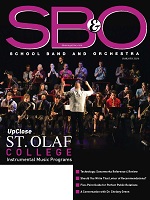 Tone, tone, oh my gosh that gorgeous oboe tone! It’s one of the highlights and most sought-after qualities of playing the oboe. It’s discussed in performance reviews, it’s evaluated in music programs, and it creates a reputation in an oboist’s career. Tone is affected by numerous factors. Tone even changes depending on where you live. So, what makes the perfect tone on oboe? It happens to be a bit of an equation. With a little bit of passion, you will find your voice come through a simple yet creative setup: (1) embouchure, (2) reed and instrument, and (3) practice.
Tone, tone, oh my gosh that gorgeous oboe tone! It’s one of the highlights and most sought-after qualities of playing the oboe. It’s discussed in performance reviews, it’s evaluated in music programs, and it creates a reputation in an oboist’s career. Tone is affected by numerous factors. Tone even changes depending on where you live. So, what makes the perfect tone on oboe? It happens to be a bit of an equation. With a little bit of passion, you will find your voice come through a simple yet creative setup: (1) embouchure, (2) reed and instrument, and (3) practice.
Oboe embouchure calls for patience and practice. It’s something I work on with my beginning students for weeks on end. Spending the extra time on this vital step in learning the oboe will do wonders for the budding oboist. Individually, we all have different facial structures. Some of us may have bigger or smaller mouths, thinner or thicker lips, and some of us may even wear braces! Variety in the size our sinuses also affect how we form the embouchure. This awareness helps us figure out what kind of setup and instruction we need to make sure those corners are tucked in and ready to play. Creating this embouchure will help any oboist become flexible and strong with whatever reed setup they have.
Reeds come into play once we have established a solid embouchure. The term “double reeds” refers to the vibration that happens between the two pieces of cane. A good quality reed will be symmetrical in the details of the scrape on each of the reed’s sides. Not only must the reed be symmetrical, but also proportional to produce a high-quality tone. With the right balance, you will have a reed that operates with good intonation, stability, and responsiveness. It all starts with a good piece of cane. Good cane will naturally help the reed have good tone and bad cane will just cause inconsistencies in tone production.
Reeds also come in a variety of shapes, styles, and thickness. Location may determine what kind of reed a teacher will have a student play. European oboe players will tend to play on the European “short” scrape style of a reed. This means, no matter what shape or thickness, the reed will only be scraped at the top half of the reed, leaving the bottom half of the reed with the original cane in place. The scrape played commonly in North America would be the “long-scrape.” The long-scrape has the entire cane part of the reed scraped from a detailed roofline to a defined back. This creates “windows.” These two styles of oboe reeds at the base level will already produce different types of tone and timbre. Whichever scrape you choose; the quality of the reed will be a factor that enhances the tone.
Finding the right reed for the oboist will complement the oboist’s embouchure. This is where shape and thickness come into play. Oboists throughout the years have created different cane shapes that may be wider or thinner. Depending on preference and embouchure shape, oboists may even prefer to have harder or softer cane. A lot of this is taught from teachers of different regions throughout the world. This means an oboist in Colorado may have a reed setup than someone playing in New York. Yes, altitude also affects reeds.
Like reeds, oboes come in a variety of models and materials, and all these factors affect tone. It is important to consider the bore of the oboe when picking the instrument that fits the oboist’s needs and setup. The bore of the oboe is the conical chamber located inside the top joint. The most common types to come across are big and thick bores, small and thin bores, and a combination of the two. Bores will alter the type of projection an oboist will have. Projection will also affect the quality of tone depending on the reed and embouchure setup. The material will also affect the timbre of the oboe sound. Lighter woods such as rosewood or cocobolo tend to produce sweeter timbres, while harder woods like grenadilla will produce darker timbres. There are even a variety of plastic, composite, and combinations as available options. From beginner to advanced models, all oboes need to be kept in good shape. Playing oboe is hard enough, and there is no need to make it harder by playing on an oboe that is “fighting you” or out of adjustment.
What does this all mean? Tone comes from a process of figuring out the individual’s needs and setup. Embouchure, reed, and instrument all go hand in hand with each other and will affect each other in many ways. My best advice is to have patience and work with oboe specialists and a company knowledgeable in these factors. It truly is an amazing process to explore the many different aspects of oboe playing to find your voice. Above all, it still requires practice to put it all together. Build those chops up with your long tones and you’ll be well on your way to wow us all with that desired tone. A mentor once told me this, and now I pass it onto you, “enjoy and trust the process.”





























